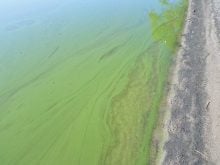If ever there was a year you pledge to start or increase the frequency of seed testing, this is it. Seed testing is arguably the most important tasks farmers perform to get the crop off to the best start possible. For a seed test to have the most value, the sample sent to the lab must be truly representative of the seed lot.
“If farmers can manage it, the absolute best way to sample grain is to use some sort of stream sampling, like when they are augering grain into bins,” says Trevor Nysetvold, president and owner of Biovision Seed Labs, which has labs in Edmonton and Grande Prairie, Alta.
Read Also

Cancer agency reclassifies another herbicide ‘probably carcinogenic’
The WHO’s cancer research agency has now put atrazine, a herbicide well known to corn growers, in the same potential-hazard category where the agency put glyphosate.
“If stream sampling is not possible, the next best way is to probe the bin. The whole idea is for the sample you take to be representative of the condition of the grain in the bin. In most, if not all, cases, the grain around the door is not representative.”
SEND SAMPLES ASAP
It’s also important to get the sample to the lab as soon as possible.
“We don’t want it to sit around in the shop or the truck for a few days,” says Nysetvold. In order to facilitate this, most labs offer prepaid courier and packing supplies.
Bin probes are easy to purchase from any agricultural supplier and most probes come with adaptors for various crops. Essentially, the adaptors change the size of the opening to allow for different seed sizes to be sampled.
This year, farmers need to watch for higher levels of diseases in all crop types due to the growing and harvest conditions in 2010.
“For example, ascochyta in peas in Alberta was at 0.9 per cent on average in 2009,” says Nysetvold. “We’re seeing 4.8 per cent from 2010. In Saskatchewan, we’re seeing 7.3 per cent in 2010 versus 1.8 per cent in 2009.
“And any disease you choose is showing the same trends. Lentils and botrytis — in Alberta and Saskatchewan in 2009, there were only trace amounts, but in 2010 it’s at three per cent on average with some samples as high as 25 per cent.”
This has several implications for the coming year.
GERMINATION TESTS ARE NOT ENOUGH
“First of all, farmers need to test their seed — a germination test alone is not enough this year,” says Nysetvold. “Standard practice indicates that for germination 85 per cent is the minimum for cereals and 90 per cent for canola, but germs are lower this year, and farmers need to know why.”
A vigour test will give a more complete story. If a germination test comes back at 75 per cent,
the other 25 per cent has a story to tell. Is germination low due to chemical damage? If so, germination will likely deteriorate further by spring. Is it due to disease? Or frost? This year Nysetvold is finding a lot of samples with frost damage and that makes germination extremely unstable.
“Vigour testing is a separate test
that is, in essence, a cool or stress test on the seed,” he says. “That way, we can evaluate performance under stress such as it will face in the field. For example, a frost-damaged sample that undergoes a vigour test will show much lower vigour than a seed without frost damage, something a germination test alone won’t be able to tell you.”
COSTS
Nysetvold is recommending farmers invest in a full complement of seed testing which includes a germination test, a vigour test and a full disease package.
“This will cost about $150 per sample, but think of it as an investment in the successful outcome of your 2011 crop,” says Nysetvold.
He also encourages retesting germination and vigour late in the spring prior to seeding as a good double-check that nothing has changed.
“Farmers should also know that they can call the lab after they receive their results if they need any questions answered,” says Nysetvold. “This is a unique year and there’s bound to be lots of questions about results.”
Saskatchewan provincial plant disease specialist Faye Dokken- Bouchard agrees with Nysetvold.
“Farmers should test their cereal and pulse seed,” she says. “On our website, they can also find comprehensive guidelines and fact sheets that will outline methods and strategies for the various management decisions they have to make this year, whether that’s understanding the tests, considering seed treatments and so on.” (Go to www.agriculture.gov.sk.ca, click on Production on the left-hand side, then Crops and go from there).
DISEASE SURVEY
There are two stories this year for Saskatchewan, says Robin Morrall, a retired plant pathologist, formerly with the University of Saskatchewan, who surveys Saskatchewan seed labs every year and publishes the results in theCanadian Plant Disease Survey.
The first concerns lentils and botrytis levels. They are 2.5 times higher than any of the previous nine years and five times the mean value of those nine years. Moreover, 30 per cent of all lentil samples have five per cent or more infection with botrytis. Added to that, most heavily infected samples also have sclerotinia and fusarium. All of these diseases are capable of causing seedling blight in otherwise viable seed.
The second story concerns Fusarium graminearumand total fusarium species (there are several, and not all cause mycotoxins) in all cereals combined. Morrall says mean levels in 2010 are five times the mean of the previous five years, and 55 per cent of all samples have over 10 per cent total fusarium infection. Eight per cent have over five per cent total fusarium infection. It is generally advised that seed treatment be considered for anything with more than five per cent infection rates.
Decisions on using infected seed or treating it depend on economic factors and availability of alternatives. Good-quality seed with seed treatments is the farmer’s best insurance toward getting a crop off to the best possible start. Not all diseases can be effectively controlled with a seed treatment. Your best bet may be to find alternative seed sources. The earlier you know what you have, the more time you have to do something about it.
AndreaHildermanhasworkedinthegrain industryforover20years,andwritesfrom Winnipeg,Man.Shehasamaster’sdegree inweedscienceandisamemberofthe ManitobaInstituteofAgrologists
———
Frost damage makes germination levels extremely unstable














